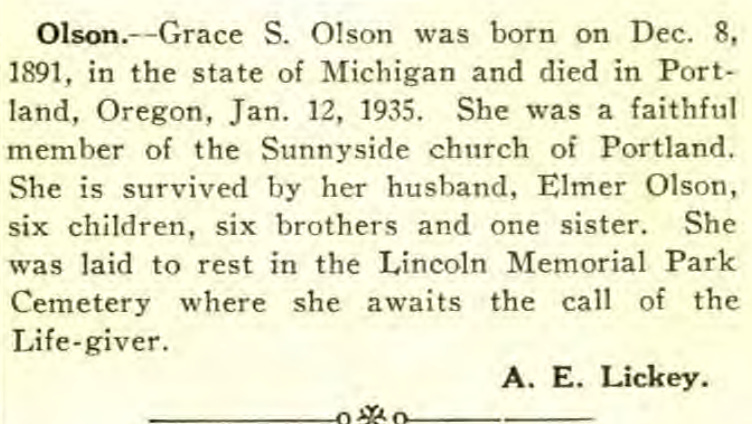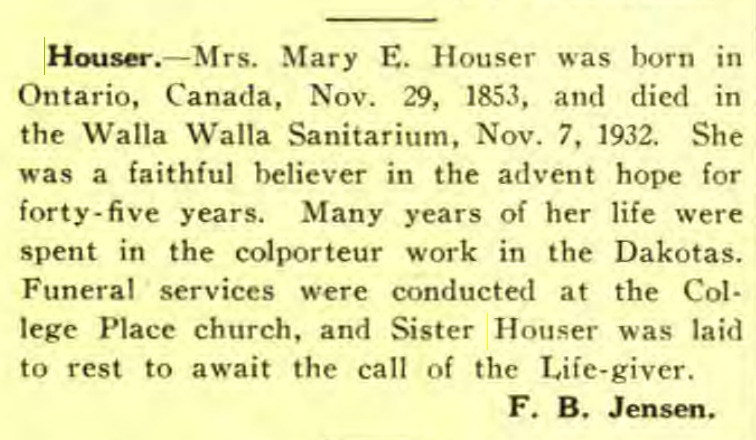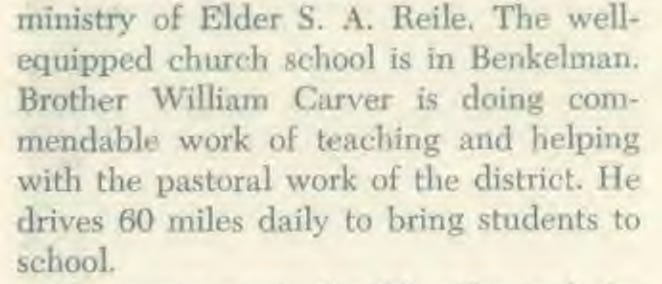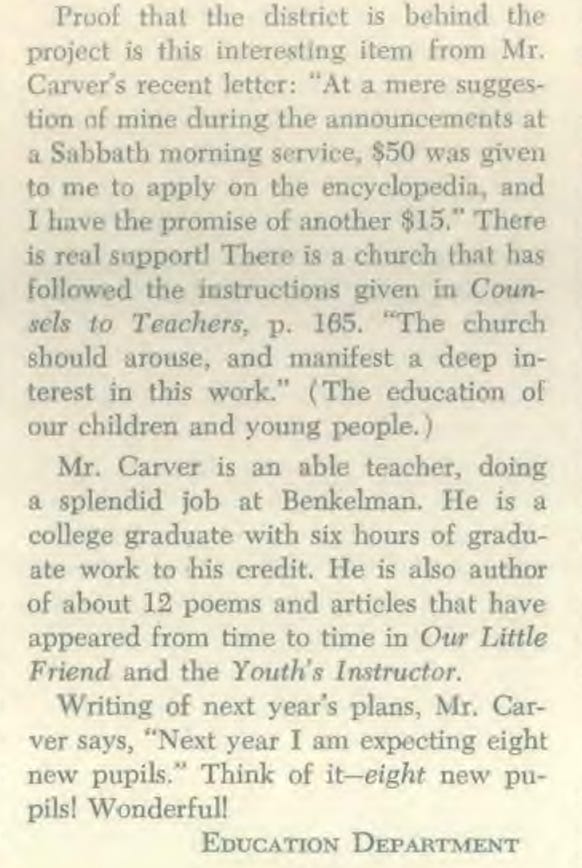Finding Family Stories in Old Church Archives
Church periodicals can contain a surprising amount of historical data.
Friday I released my latest video. You can watch it here:
This particular post is meant to accompany that video. It will still make sense on its own but will be more clear if you watch first and then read this afterwards.
Church archives can be a gold mine of information. It depends on the types of publications a particular denomination published, but they may contain mentions of the standard items you expect to get from church records and, added bonus, news articles that mention your ancestors at various other events.
In the video I find a photo of myself at age 10, a detailed list of how much money some relatives made from selling books years earlier, and a poem written by my dad during World War II.
But how did I know this was Dad’s? It’s just a publication with a poem and his name. There’s no biography. And “William Carver” isn’t terribly unique.
Near Matches
The Familysearch research wiki explains some of the pitfalls of looking at online records collections. Sometimes when you find an article containing your relative’s name, you assume it is yours, but maybe it’s a “near match” that isn’t really a match. For instance, perhaps the name is the same, but once you look more closely, you find that dates don’t match up.
Alternatively, sometimes the name isn’t an exact match. It has a typo, a nickname, or old-fashioned spelling. But it might actually be the person you’re looking for. And if a person is completely missing, that does not automatically mean that person wasn’t in the area. Sometimes the record set is incomplete. Maybe a few pages didn’t get scanned into the system for some reason.
Organizational Tactics
The wiki goes on to suggest some some ways to help with verification. Before you start hunting, round up all your information. Open your family tree. Gather your notes. The more you know, the easier it is to verify. Try to find the full name, the names of spouses, as many of the birth, marriage, and death dates as you know, names and approximate birthdays for the children, residences, occupations, and military service. (See FamilySearch Link at end of post.)
Sometimes when I’m searching through archives I don’t have much of this information. I’ll come across a name, and I’m uncertain, so I put it in a special “maybe” pile, to be re-evaluated as more facts surface.
Case Study 1: Self-Verification in Church Publications
The simplest verification was finding myself in the North Pacific Union Gleaner. The photo showed me in a scout uniform at Mount Tabor Church, wearing some super dandy glasses. I verified this was me through:
Direct visual identification. At first glance I recognized myself and both of the other people in the picture.
Personal memories. I remembered the location, the scout meetings, the time frame, and the fact that those glasses were always falling down my nose.
Search for More Matches
But let’s say a descendant finds this photo 50 years from now, without the context I have. That’s where it is useful to search for, and examine, as many results as possible.
In this case, if my descendant looks through all four of the articles that show up when you search for my name, that lucky little researcher will find another photo from the same year. It’s my baptism photo and shows my glasses and haircut from a different angle. The baptism date also coincides with the baptism date in my family tree which, I hope, my descendant will be able to find.
Case Study 2: Verifying Grandma Grace
For my grandmother's death notice, I verified by matching this notice with other sources:
The death notice details exactly matched her official death certificate (dates and locations).
There was also a second death notice in a sister publication that provided several more details, including the name of the church she attended, her husband’s name, number of children, and burial location. Each piece of information aligned with known family records and stories.
Case Study 3: Great Grandma Mary McGuffin
The first two cases were pretty easy, right? I recognized myself, and Grandma’s details all lined up with existing records.
But what about Great Grandma? In the video, I showed a couple of notices that said things like, “Mary McGuffin is selling religious books around South Dakota.”
These articles mentioned name and location. South Dakota was sparsely populated, Mary McGuffin isn’t the most common name, and Mary’s religion isn’t the primary religion of the area. These facts all help, but that doesn’t mean I can jump to the conclusion that this Mary is my great grandmother. Did my Mary roam the countryside selling books? How can I find out?
Here’s where it’s good to have your family tree open, so you can refer to it for name changes. It also helps to have some insider knowledge of the church your ancestor attended.
What did I find?
Verification of her occupation from other articles.
Let’s start with her death notice. By late 1922 my grandmother’s family had moved to Washington state, and it appears Great Grandma tagged along. In 1923 she married David Houser. A search for Mary Houser provides her death notice a decade later. This lines up with her death certificate. It mentions that she was a church member for 45 years and says she spent many years in the colporteur work in The Dakotas.
Small side note: This contains a few terms that my sweet little descendants might not understand when they search for Great Grandma years from now. So here’s a quick decoder.
Walla Walla Sanitarium: A hospital. This church loved its sanitariums. Note that in the video, my dad and uncle worked at the Portland Sanitarium and Hospital.
Colporteur: Someone who travels from place to place selling or giving away religious materials, particularly Bibles and faith-based literature. This church also loved its missionaries and colporteurs.
The Dakotas: A quick way to talk about both North and South Dakota, two states in the midwest of the United States. At one time they were both part of the Dakota territory.
Geographic Verification
From other records, I know that the tiny town where Great Grandma lived in 1915 was called Line, South Dakota. This place was so small the “Welcome” and “Good-bye” signs probably shared the same post. The truth is, I’m not even sure exactly where it was, because I can’t find it on any maps now. I’m guessing it was near Cave Hills, but that’s just a guess.
Some of the “Book Selling” reports mentioned Line:
“I am sending you this report with good courage. Sister Mary E. McGuffin, Line, S. D.” Northern Union Reaper, Vol. 14 No. 24, June 24, 1919
"Sister Mary McGuffin reports three new Sabbath keepers in Line, S. Dak." - The Advent Review and Sabbath Herald, Vol. 92 No. 21, Thursday, April 29, 1915
While it’s certainly possible to have more than one Mary McGuffin selling books for the church in The Dakotas during this time frame, would there be more than one from Line? Well, it’s not impossible, but it doesn’t seem likely.
Case Study 4: Orland William (Bill) Carver
Verifying my father's records helped fill in more details on his timeline. This is another situation where William Carver isn’t a particularly unique name, and Dad moved around a bit.
Not only that, the Adventist Yearbooks for the years 1951-1955 do list him under “Church School Teachers” in the midwest, but for 1951 it also lists another William Carver under “Ministers.”
Fortunately, I do have a lot of oral tradition. Dad told stories. He wrote many of them down. I know he was not a minister. When reviewing articles for this time frame in the midwest, I need to be careful to note when the articles are speaking of a teacher vs. a minister.
1934: Selling Books
Oral History: Colporteur records matched his stories about selling books during the Depression, riding an electric bike from town to town.
Recent corroborating stories: Some of the cousins I’ve connected with in recent years have mentioned how Uncle Bill gave them some of these books as gifts.
1943: Published Poem During WWII
This one is a bit harder. I paged through the entire issue, past a piece entitled “Lads, Lassies, and Liquor” and a full column explaining why you might want to become an auto mechanic. But alas, there is no bio for the poet.
So how can I verify?
Oral History: He told me he wrote stories and poems for these publications during the war, but that he no longer had copies of what he published.
Additional articles: One article announces that he will be the new school teacher and mentions that he has published 12 pieces in various church publications.
The writing in this poem matches his style, and I have hundreds of pages of his writing for comparison. This is inherently subjective, of course, but when I combine it with the other evidence, I’m comfortable with it.
1955: Teaching School
Visual verification: His photo. I mean, ok, that’s him. If my future descendants see the photo, they should have plenty of other photos to compare it with.
Oral history. He spoke of his teaching experiences often.
Additional articles. These all show him right where I expect him to be, teaching school in little one room situations, with something like 18 students in multiple grades.
1958: Marriage
Dates, people, location, all corroborated by many other sources.
Making the Case: Your Verification Toolkit
When you're digging through old church magazines trying to figure out if that person is really your relative, here are some of the tricks that worked for me.
Connect the Dots
Look for details that match up with what you already know - full names (don't forget maiden names), physical descriptions, where they lived.
Look at the near-matches carefully. Check everything against known facts, and if you aren’t sure, put these in your “maybe” pile.
Follow the Timeline
Make sure the dates make sense - birth, marriage, death, moves from one place to another.
Look for logical life progressions - when you can follow someone's journey (like my father's path from book seller to teacher, mentioned in multiple publications), it helps confirm you're following the right person.
Look for multiple records from the same time period that confirm each other - like when a church announcement, personal stories, and official documents all place someone in the same location doing the same thing.
Look at the Bigger Picture
Find patterns - if multiple sources mention the same job or the same move to a new state, that's useful evidence
Be honest about what you're not sure about - sometimes you have to say "probably" instead of "definitely"
Think of verification as a family puzzle - one piece might look right, but when you find three or four that fit perfectly, that's when you know you're onto something.
Links For Further Research
If you have ancestors in this particular church, check out the Adventist Archives here: https://documents.adventistarchives.org/default.aspx
For relatives with different faith backgrounds, check the FamilySearch Wiki page below. (This is for the U.S., but you should be able to find other countries with similar pages, as needed.) https://www.familysearch.org/en/wiki/How_to_Find_Church_Records_in_the_United_States#







What a thorough explainer of verification — what it is, why it is imports t and examples of how to do it. Great job! Plus what an adorable little Scout you were!